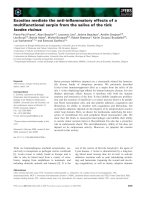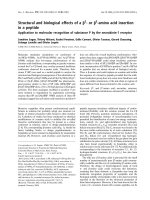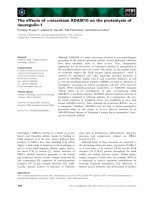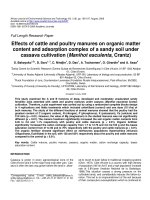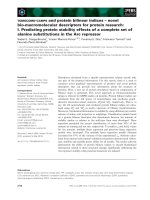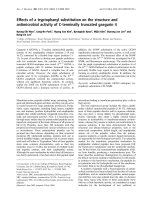Effects of cattle and poultry manures on organic matter content and adsorption complex of a sandy soil under cassava cultivation (Manihot esculenta, Crantz) doc
Bạn đang xem bản rút gọn của tài liệu. Xem và tải ngay bản đầy đủ của tài liệu tại đây (109.04 KB, 8 trang )
African Journal of Environmental Science and Technology Vol. 3 (8), pp. 190-197, August, 2009
Available online at
DOI: 10.5897/AJEST09.072
ISSN 1991-637X © 2009 Academic Journals
Full Length Research Paper
Effects of cattle and poultry manures on organic matter
content and adsorption complex of a sandy soil under
cassava cultivation (Manihot esculenta, Crantz)
S. Bakayoko
1,2
*, D. Soro
1, 2
, C. Nindjin
1
, D. Dao
1
, A. Tschannen
1
, O. Girardin
3
and A. Assa
4
1
Swiss Centre for Scientific Research (Centre Suisse de Recherches Scientifiques) in Côte d’Ivoire, 01 BP 1303 Abidjan
01, Côte d’Ivoire.
2
University of Abobo-Adjamé (University d’Abobo-Adjamé), UFR SN, Laboratory of biology and crop production, 02 BP
801 Abidjan 02, Côte d’Ivoire.
3
Rural Foundation of Jura, Courtemelon Loveresse (Fondation Rurale Interjurassienne), Post-office box: 65/2852,
Courtetelle, Swiss.
4
University of Cocody (University de Cocody), UFR STRM, Laboratory of Soil Science and Geology, 22 BP 582 Abidjan
22, Côte d’Ivoire.
Accepted 14 July, 2009
This study examined the A and B horizons of deep, developed and moderately unsaturated sandy
ferrallitic soils amended with cattle and poultry manures under cassava (Manihot esculenta Crantz)
cultivation. Therefore, a plot experiment was carried out by using a randomized complete blocks design
in 4 replications and fields treatments which included unfertilized (control) and one dose (10 t/ha) of
both manures. The study of the different fractions of animal manures showed that the poultry had the
greatest content of C (organic carbon), N (nitrogen), P (phosphorus), K (potassium), Ca (calcium) and
C:N ratio (p < 0.01). However, the value of Mg (magnesium) in the studied manures was not significantly
different (p < 0.01). The manure treatment significantly increased the soil organic matter contents from
0.46 to 2.8 and 1.1% respectively with poultry and cattle manures (p < 0.01). Organic fertilizer
significantly increased the cation exchange capacity from 1.7 to 12.75 and 3.8 me:100 g and the bases
saturation content from 47 to 80 and to 76% respectively with the poultry and cattle manures (p < 0.01).
The organic fertilizer showed significant effect on earthworms populations Hyperiodrilus africanus
(Oligochaeta, Eudrilidae) in the soil, with 128 and 85% respectively about the poultry and cattle manures
compared to the control (p < 0.01).
Key words: Cattle manure, poultry manure, cassava, organic matter, cation exchange capacity, bases
saturation content.
INTRODUCTION
Cassava is grown in every agroecological zone of the
Côte d’Ivoire and it is the major food crop after yam. Cas-
sava is often the last crop grown before the land is allow-
*Corresponding author. E-mail: ,
Tel.: +225 23 47 27 90/07 41 41 83.
Fax: +225 23 45 12 11.
ed to revert to bush fallow in traditional cropping systems
(Ofori, 1973). Côte d'Ivoire is a country with high density
of population (48 inh./km
2
) and a high population increase
rate of 3.8%/year (Institute National de la Statistique,
1998).This situation causes a strong pressure on the
cultivable lands, and considerably reduces the fallow du-
ration. This led to an impoverishment of the soil because
of their consecutive overexploitation which is combined to
bush fires actions (Carsky, 2003). Swarup et al (2000)
reported the loss of soil organic carbon, particularly C
and N, under intensive cropping and continuous
cultivation. The decline in soil productivity as a result of
continuous cultivation in sub-Saharan Africa has been
identified as a major cause of food insecurity and poverty
and crop yields continue to decline on smallholder
farmers fields and there is a huge gap between potential
crop yields and actual crop yields (Yeboah et al.,
2009).The degradation induces a significant decrease of
the soil organic matter content which modifies the
nitrogen cycle (Ouattara et al., 2006). Moreover, in Côte
d’Ivoire, the low levels of organic matter and total nitro-
gen (N) were the major soil constraints identified (Asadu
et al., 1998). The soil constraints that reduce the yields of
cassava such as soil alkalinity and salinity, exchangeable
aluminium (Al), high pH above 8.0 and exchangeable so-
dium (Na) percentage of above 2.5% have been outlined
by Cock and Howeler (1978).
In the other side, the farms generate an enormous
amount of manure. The disposal of these wastes is one
of the main environmental problems related to intensive
livestock production. The use of manures as organic ferti-
lizer can benefit agriculture and can be, potentially, an
inexpensive way for society to protect the environment
and to conserve natural resources.
Research studies about the cattle manure, aiming the
soils fertility regeneration, were implemented elsewhere
(Nyamangara et al., 2001; Arriaga and Lowely, 2003;
Hao et al., 2004). The information on effect of poultry and
cattle manures on soil quality is limited in Côte d’Ivoire.
Indeed, the quantification of the organic matter content,
the sum of the exchangeable bases cations, the cation
exchange capacity and the bases saturation content are
of prime importance in identifying sustainable systems for
manures dynamics in the soil.
In this study, research programs were carried out in
2002 on plots which were continuously cultivated, since
1992. After the physical and chemical characterizations
of these soils, a fertilization trial with cattle and poultry
manures under cassava crop were carried out. At the end
of the cropping season, each treatment soil was sampled
and analyzed. Mineralisation of humus takes place at a
slow rate which varies mainly in relation to temperature
and soil wetness, factors over which no management
controls can be exerted (Moares et al., 2001), Harris
(2002) pointed the importance of manure as a nutrient
source in the nutrient balances of two farming systems.
The objectives of this study were: i) The characterisa-tion
of the different organic matter in animal manures. ii) The
determination of the manures effects on organic matter
content and adsorption complex of the soil under cassava
cultivation.
Bakayoko et al. 191
MATERIALS AND METHODS
Site description
The study was carried out on the experimental field of the Swiss
Centre for Scientific Research in Bringakro (altitude 150 m,
06°40´N, 05°09´W) located at 180 km from Abidjan (Côte.d'Ivoire)
northward. The climate is a transition of the equatorial climate cha-
racterized by the alternation of long rainy season (from March to
July) with an average rainfall of 850 mm, a short dry season (from
July to August), a short rainy season (from September to October)
providing approximately 185 mm and a long dry season (from
November to February). The Harmattan, dry wind blows from
December to February during the long dry season. The annual
average temperature was 26°C with average air moisture of 77%
and a monthly total solar radiation of 394 MJ /m
2
from 2002 to
2006. The experiment began in 1992 with a yam crop on land
cropped to yam during 10 years. After a short fallow period of 2
months the soil was primarily covered by Imperata cylindrica
(Poaceae), Chromolaena odorata (Asteraceae).
The morpho-pedological characterization indicated the presence
of well draining soils and wet in-depth. In each horizon, the colour
was homogeneous (dark in the top horizon and red in the depth
horizon). Twenty seven (27) pedological pits of 1 m depth were
excavated in the field to examine the soil profile and ensure that the
same soil type was present. Soil samples were taken according to
horizon levels (top horizon (0 - 22 cm) and subjacent horizon (22 -
55 cm)) and analyzed at the laboratory. These taking away were
made at cuttings planting time in June.
The Table 1 shows initial soil physical and chemical (carbon,
nitrogen and organic matter content) properties. Particles size distri-
bution was measured after oxidation of the organic matter with
hydrogen peroxide (H
2
O
2
) of a soil sample sieved through 2 mm
mesh, followed by particles dispersion with a sodium hexameta-
phosphate solution (NaPO
3
)
6
(Van, 1993)
.
Sands were dominating in
the topsoil (approximately 80%). The clay content increased gra-
dually with soil depth (5.2 to 8.6%) but remained lower than silts
which had approximately 13%.
The initial soil chemical properties (cations exchange capacity,
potassium, calcium, magnesium and sodium contents, sum of ex-
changeable bases cations and bases saturation rate) for the site
under study are presented in Table 2. Soil organic carbon was
determined using the Walkley and Black method (1934). The total
nitrogen was measured by dried combustion and by Kjeldahl me-
thod (Moral et al., 2005). The exchangeable base cations (Na
+
, K
+
,
Ca
2+
, Mg
2+
) were extracted with the ammonium acetate (NH
4
Oac)
and proportioned by spectroscopy of atomic absorption for Ca et
Mg and by spectroscopy from emission to flame for Na et K (Houba,
1995). The cation Ag
+
contents were determined by comparison
with those obtained with a “white” witness sample. Exchangeable
aluminium (Al
3+
) and extractable hydrogen (H
+
) by the cobalti-
hexamine were measured by AFNOR methods (AFNOR, 1996).
METHODS
Chemical characteristics of Cattle and poultry manures
The analyses of the chemical characteristics of poultry and cattle
manures used are summarised in the Table 3. The dry manure
samples of cattle were obtained in 7 bovine parks (average age: 2
years) of the village of Bringakro. Concerning the poultry manure, it
192 Afr. J. Environ. Sci. Technol.
Table 1. Initial soil physical and chemical (carbon, nitrogen and organic matter content) properties at 0 - 22 and 22 - 55 cm soil layers in the
ferrallitic soil of the Toumodi area, Côte d’Ivoire. Data are means ± standard error.
Horizon
Clay
(%)
Fine silt
(%)
Coarse silt
(%)
Fine sand
(%)
Coarse sand
(%)
C
(%)
N
(%)
C:N
Top
0 - 22 5.4 ± 0.6 5.3 ± 0.4 7 ± 1.2 18 ± 2.3 64.3 ± 6.1 0.53 ± 0.08 0.045 ± 0.002 12 ± 0.9
22 - 55 8.8 ± 0.7 3.9 ± 0.1 7.4 ± 0.8 16.2 ± 1.9 62.3 ± 4.9 0.34 ± 0.04 0.045 ± 0.007 8 ± 0.7
Middle
0 - 22 5.2 ± 0.9 5.6 ± 0.3 9.4 ± 1.4 20 ± 2.5 59.8 ± 5.3 0.52 ± 0.07 0.045 ± 0.006 12 ± 0.9
22 - 55 8.6 ± 1.1 4.1 ± 0.2 7.8 ± 1.1 20.2 ± 2.6 59.3 ± 5.1 0.34 ± 0.05 0.045 ± 0.008 8 ± 0.9
Base
0 - 22 5 ± 0.3 5.9 ± 0.2 12.7 ± 1.3 20.8 ± 1.9 55.6 ± 4.8 0.52 ± 0.09 0.045 ± 0.004 12 ± 0.2
22 - 55 8.4 ± 0.7 4.3 ± 0.3 8.5 ± 0.9 24.8 ± 2.9 54 ± 3.9 0.34 ± 0.07 0.045 ± 0.004 8 ± 0.3
Mean
0 - 22 5.2 ± 0.7 5.6 ± 0.3 9.7 ± 0.6 19.6 ± 2.3 59.9 ± 5.5 0.52 ± 0.08 0.045 ± 0.004 12 ± 0.6
22 - 55 8.6 ± 0.9 4.1 ± 0.2 7.9 ± 0.9 20.4 ± 2.5 58.5 ± 4.8 0.34 ± 0.06 0.045 ± 0.006 8 ± 0.5
Table 2. Initial soil chemical properties (cations exchange capacity, potassium, calcium, magnesium and sodium contents, exchangeable
bases sum and bases saturation rate) at 0 - 22 and 22 - 55 cm soil layers in the ferrallitic soil of the Toumodi area, Côte d’Ivoire. Data are
means ± standard error.
Horizon CEC
(me:100 g)
Ca
(me:100 g)
Mg
(me:100 g)
K
(me:100 g)
Na
(me:100 g)
S
(me:100 g)
V
(me:100 g)
Top
0-22 2.4 ± 0.2 0.733 ± 0.03 0.066 ± 0.007 0.058 ± 0.001 0.023 ± 0.004 0.88 ± 0.09 37 ± 2.5
22-55 2.8 ± 0.5 0.604 ± 0.08 0.064 ± 0.007 0.048 ± 0.003 0.033 ± 0.004 0.749 ± 0.09 27 ± 1.9
Middle
0-22 2.4 ± 0.3 0.733 ± 0.06 0.067 ± 0.003 0.058 ± 0.007 0.024 ± 0.002 0.882 ± 0.01 37 ± 2.3
22-55 2.8 ± 0.5 0.602 ± 0.01 0.064 ± 0.009 0.048 ± 0.004 0.033 ± 0.003 0.747 ± 0.07 27 ± 0.9
Base
0-22 2.4 ± 0.9 0.733 ± 0.05 0.068 ± 0.004 0.058 ± 0.005 0.022 ± 0.003 0.881 ± 0.03 37 ± 0.7
22-55 2.8 ± 0.7 0.6 ± 0.04 0.064 ± 0.008 0.048 ± 0.006 0.033 ± 0.007 0.745 ± 0.06 27 ± 0.8
Mean
0-22 2.4 ± 0.5 0.733 ± 0.04 0.067 ± 0.006 0.058 ± 0.004 0.023 ± 0.005 0.881 ± 0.04 37 ± 1.7
22-55 2.8 ± 0.6 0.602 ± 0.2 0.064 ± 0.008 0.048 ± 0.004 0.033 ± 0.009 0.747 ± 0.08 27 ± 1.2
Table 3. Chemical characteristics of poultry and cattle manures used. Data are means ± standard error.
Manure type C (%) N (%) P (%) K (%) Ca (%) Mg (%) C:N
cattle 26.52 ± 1.1b 0.92 ± 0.01b 0.19 ± 0.01b 0.79 ± 0.01b 0.48 ± 0.02b 0.31 ± 0.03a 28.83 ± 0.1b
poultry 30.93 ±1.6a 2.09 ± 0.03a 0.87 ± 0.02a 0.97 ± 0.05a 1.06 ± 0.03a 0.34 ± 0.02a 14.8 ± 0.2a
Different letters within a column represent significant difference (t-test, p < 0.01).
was collected in 3 firms of the area. Poultry manures had a storage
time in the heaps ranged from five to seven months. The manure
samples were analyzed at the laboratory. All samples were dried in
a forced-air oven at 60°C and ground to 0.5 mm for analysis. Total
organic carbon was determined by oxidation with K
2
Cr
2
O
7
in H
2
SO
4
,
according to Yeomans and Bremner (1989). NH
4
+
-N was extracted
with 2 M KCl and determined calorimetrically by the phenol salt me-
thod (Honeycult et al., 1991). NO3
-
-N was determined by second-
derivative spectroscopy in a 1:30 (w/v) water extract (Sempere et
al., 1993). Total nitrogen (N
t
) and organic nitrogen (N
org
) were cal-
culated as the sum of Kjeldahl-N and NO3
-
-N and as the difference
between N
t
and the inorganic nitrogen (sum of NH
4
+
-N and NO3
-
-
N), respectively. Manure samples were also analysed to determine
with 0.1 M HCl + 0.03 M NH
4
F (Bray II method) extractable P and K
(Salinas and Garcia, 1985), 1 M KCl extractable Ca, Mg (Thomas,
1982).
Experimental design
The trial was set up according to a randomized complete blocks
design. Three (3) treatments with four (4) blocks containing 4 repli-
cations per treatment were set up in experimental plots of 64 m
2
each, with 1 m distance between plots. The manure was spread at
the dose of 10 t/ha
after randomization. Then, the plots were
ploughed and uniformly mixed with the manures before planting the
cassava. Cassava cuttings were planted on 6 June, 2002. The
second test was set up, one year after, then, at the same date in
2003. Each treatment was sampled (9 taking away) for 2 layers of
soil (0 - 22 and 22 - 55 cm). These taking away were made at the
harvest time at 15 month after planting in September.
Depth of horizon was measured by digging small pits, then mea-
suring the depth where soil colour changed using the Munsell soil
colour charts (Munsell (1954) cited in Schlichting et al. (1995)).
Extraction method and evaluation of earthworms’ population
The earthworms were identified on all the treatments in the soil of 6
pits per treatment at 15 months after planting. Each pit measured 1
m length on 1 m breadth and 70 cm depth. The earthworms were
collected together with the soil in a bucket which was regularly emp-
tied on a plastic bag to locate the earthworms finely and count them
thereafter.
Statistical methods
The data were subjected to the analysis of variance according to
the experimental design (linear model with interactions), by the ana-
lysis software SAS® (Statistical Analysis System Institute Inc.,
Cary, NC, USA). For the significant effects, the averages were com-
pared using Student-Newman_Keuls method (Dagnelie, 2003).
RESULTS
Manures effects on earthworms population in the soil
The Figure 1 shows the average number of earthworms
in the amended soils. The average numbers of earth-
worms H. africanus (Olgochaeta, Eudrilidae) which were
7, 13, and 16 per m
2
at 0 - 55 cm soil layers, respectively
in the control plots, cattle manure plots and poultry ma-
nure plots were significantly affected by the manure (p <
Bakayoko et al. 193
c
b
a
Soil nM (control) Soil + cM Soil + pM
0
2
4
6
8
10
12
14
16
18
20
Number of earthworms
Treatments
Figure 1. Average number of earthworms at 0 - 55 cm soil
layers in one m2 of the sandy soil under cassava cultivation at
15 months after planting, according to fertilisation mode
during the 2 consecutives crop years, without manure, cattle
manure and poultry manure, Toumodi, Côte d’Ivoire. Errors
bars are SE, histograms surmounted by different letter are
significantly different at p < 0.01. nM: no Manure (control); cM:
cattle manure; pM: poultry manure.
0.01). This corresponded to an increase of 85% of earth-
worm population under cattle manures and 128% under
manure poultry compared to the control.
Manures effects on soil colour and particles size
distribution
The colour of the horizons was variable, ranging from
boards 2.5 YR to 10 YR. However, under the control,
100% of the samples were in the boards 10 YR whereas
under manure, there was only 25%, with 62.5% in the
board 7.5 YR and 12.5% in the board 2.5 YR. The Table
4 shows the particle-size distribution in the treatments for
0 - 22 and 22 - 55 cm soil layers. The soils with manures
had significantly higher clay and silt contents than those
of the control (p < 0.01). However, the sand content was
not significantly affected by either treatment. The parti-
cles size distribution of the soil indicated very sandy soils
under the control, sandy under the cattle manure, sandy
on the top horizon (0 - 22 cm) and sandy-clay on the sub
horizon (22 - 55 cm) under the poultry manure. The clay
contents were higher in the soil samples under manure.
Manures effects on the soil chemical characteristics
The amended soils had largest amount of organic matter,
194 Afr. J. Environ. Sci. Technol.
Table 4. Particle-size distribution in the treatments for 0 - 22 and 22 - 55 cm soil layers, under cassava cultivation at 15 months
after planting, according to fertilisation mode during the 2 consecutives crop years, without manure, cattle manure and poultry
manure, Toumodi, Côte d’Ivoire. Data are means ± standard error.
Treatments (cm) Clay (%) Fine silt (%) Carse silt (%) Fine sand (%) Coarse sand (%)
Soil nM (control)
0 - 22 5.6 ± 0.2c 4.8 ± 0.2d 8.3 ± 0.4d 40 ± 2.9a 41.3 ± 3.2ab
22 - 55 5.77 ± 0.1c 2.5 ± 0.1e 8.8 ± 0.2c 34.9 ± 1.6b 46.2 ± 2.6a
Soil + cM
0 - 22 9.95 ± 0.9b 6.3 ± 0.3b 10 ± 0.3a 30.1 ± 2.2c 44.2 ± 1.7a
22 - 55 6.95 ± 0.3b 10.1 ± 2.2a 8.6 ± 0.4bc 35.9 ± 1.9ab 37.8 ± 0.7bc
Soil + pM
0 - 22 8.65 ± 1.1b 6 ± 0.7b 9 ± 0.5b 32.4 ± 2.7b 43.9 ± 2.3a
22 - 55 16.5 ± 2.6a 5.5 ± 0.2c 7.4 ± 0.6d 30.4 ± 0.8c 40.1 ± 2.5b
Values in the same column with different letter are significantly different at p < 0.05. nM: No Manure (control); cM: cattle manure; pM:
poultry manure.
c
c
b
b
a
a
0 - 2 2 2 2 - 5 5
0 . 0
0 . 5
1 . 0
1 . 5
2 . 0
2 . 5
3 . 0
3 . 5
4 . 0
Organic matter content (%)
S o il l a y e r s ( c m )
n M
c M
p M
Figure 2. Responses in soil organic matter content at 0 - 22 and 22 - 55 cm soil layers in the sandy
soil under cassava cultivation at 15 months after planting, according to fertilisation mode during the 2
consecutives crop years, in the ferrallitic soil of the Toumodi area, Côte d’Ivoire. Errors bars are SE;
histograms in the same soil depth, surmounted by different letter are significantly different at p < 0.01.
nM: no Manure (control); cM: cattle manure; pM: poultry manure.
sum of the exchangeable bases cations, cation exchange
capacity and bases saturation. The difference between
control values and manure values were significant (p <
0.01).
The organic matter content (Figure 2) of the soil was
very low in the control (0.25 - 0.46%). It significantly in-
creased in the soils treated with cattle manure (1.1% in
the top horizon) and with poultry manure (2.9% in the top
horizon).
The sum of the exchangeable bases cations (S) (Figure
3) was significantly higher under manure (2.9 - 10.2 me:
100 g)) than under control (0.8 me:100 g) (p < 0.01). The
CEC (Figure 4) was significantly lower under the control
(1.7 - 1.8 me:100 g) than under the poultry manure (8.5 -
12.8 me:100 g) and the cattle manure (3.8 - 11 me:100 g)
(p < 0.01).
The bases saturation content (V) (Figure 5) increased
with the application of the manure. It significantly ranged
from 47% with the control to 76% under cattle manure
and 80% under poultry manure (p < 0.01). S, CEC and V
are the three values characterizing the soil adsorbent
complex.
Bakayoko et al. 195
c c
b
b
a
a
0-22 22-55
0
2
4
6
8
10
12
sum of the exchangeable bases cations (me:100 g)
Soil layers (cm)
nM
cM
pM
Figure 3. Responses in soil sum of the exchangeable bases cations at 0 - 22
and 22 - 55 cm soil layers in the sandy soil under cassava cultivation at 15
months after planting, according to fertilisation mode during the 2 conse-cutives
cropping years, in the ferrallitic soil of the Toumodi area, Côte d’Ivoire. Errors
bars are SE; histograms in the same soil depth, surmounted by different letter
are significantly different at p < 0.01. nM: no Manure (control); cM: cattle manure;
pM: poultry manure.
c
c
b
b
a
a
0-22 22-55
0
2
4
6
8
10
12
14
cation exchange capacity (me:100 g)
Soil layers (cm)
nM
cM
pM
Figure 4. Responses in soil cation exchange capacity at 0 - 22
and 22 - 55 cm soil layers in the sandy soil under cassava
cultivation at 15 months after planting, according to fertilization
mode during the 2 consecutives crop years, in the ferrallitic soil
of the Toumodi area, Côte d’Ivoire. Errors bars are SE;
histograms in the same soil depth, surmounted by different
letter are significantly different at p < 0.01. nM: no Manure
(control); cM: cattle manure; pM: poultry manure.
c
c
b
b
a
a
0-22 22-55
0
10
20
30
40
50
60
70
80
90
bases saturation content (%)
Soil layers (cm)
nM
cM
pM
Figure 5. Responses in soil bases saturation content at 0 - 22
and 22 -55 cm soil layers in the sandy soil under cassava
cultivation at 15 months after planting, according to fertilisation
mode during the 2 consecutives cropping years, in the ferrallitic
soil of the Toumodi area, Côte d’Ivoire. Errors bars are SE; his-
tograms in the same soil depth, surmounted by different letter
are significantly different at p < 0.01. nM: no Manure (control);
cM: cattle manure; pM: poultry manure.
196 Afr. J. Environ. Sci. Technol.
DISCUSSION
In this research, the aims were to study the organic
fertilization effects on the status of a sandy soil and its
relationships to other edaphic characteristics (physical,
chemical and biological).
Concerning the manures analysis, the average carbon
content ranged from 26.52 to 30.93%, with, statistically,
the poultry and cattle manures having highest and lowest
carbon concentration, respectively. However, all the ma-
nures had carbon contents higher than the limit set by the
Spanish legislation for organic fertiliser (18% C) (BOE,
1998). The N concentration ranged from 0.92 to 2.09%,
with only the poultry manure showing a value of this para-
meter above the limit set for organic fertiliser (2% N)
(BOE, 1998). The organic amendment quality and their
capacity to provide nitrogen are generally evaluated by
the C:N ratio (Stevenson, 1984). The poultry manure had
significantly the lowest C:N ratio value (14.8) compared
to cattle manure (the C:N ratio value was 28.83). This low
value was due to its N content being the highest. All the
manures showed a C:N ratio greater than the range of
values for organic fertilisers (C:N = 3 - 15) (BOE, 1998).
The carbon of these manures might have started its bio-
degradation process during the storage in heaps at the
margins of the farms. In all manures, the C:N ratio was
over 12, which is the maximum value for mature com-
posts prepared with a wide range of organic wastes
(Bernal et al., 1998).
When litter with a high C:N ratio (approximately 30/1 or
higher) is added to soil, net immobilisation may occur for
a period of time (days to weeks) which is dependent on
the prevailing soil moisture and temperature. After a pro-
portion of C from the litter source has been consumed by
organisms and respired (significantly reducing the overall
C/N ratio of the substrate) net mineralization may occur
(Peter and Sinclair, 2001).
The manures influenced the soil infection by the earth-
worms. It is besides a good indicator of the soil fertility
because the worms’ casts have a strong assimilable ni-
trogen content, trace elements, organic matter, phospho-
rus and potassium (Flückiger et al., 1998). The worms dig
galleries; also take part in the ventilation of the soil and
its drainage, hence more water would be available for
root growth. The higher number of earthworms with the
poultry litter would be explained by the fact that the
organic matter content is the highest.
The organic fertilization allowed significant increases in
the soil organic matter contents in the 0 - 22 cm layer.
That is due to the fact that the manure amendments on
soil provide the nutritive elements by mineralization (Fan
et al., 2004; Wuest et al., 2005). These results are similar
to those of Wang et al. (2006) who observed that the
cattle manure increased significantly the concentrations
of the organic matter. The increase in the organic matter
induced by the amendment is due to the manures which
has three roles of organic matter sources, of protection of
the soil against erosion and of increase in the activity of
earthworms which reduce water runoff (Hole et al., 2005;
Parfitt et al., 2005). In accordance with our results and
with those of Hao and Chang (2002), the cattle manure
involved an increase in the sum of the exchangeable
bases cations (Ca
2+
, Mg
2+
, K
+
, Na
+
) and the cation ex-
change capacity (Ca
2+
, Mg
2+
, K
+
, Na
+
, H
+
, Al
3+
). This ten-
dency was accentuated with the poultry litter. Under the
climatic conditions where the temperature and moisture
are high, the mineralization processes of the organic mat-
ter of the soil are intense (Thuriès et al., 2000). This trend
is observed because of the usual greater microbial activi-
ties associated due to organic matter accumulation.
The manures significantly increased in the same
occasion the content of saturation in bases (V=S:CEC).
The amended soils were more fertile than the control,
and this is reflected by the significant difference between
the bases saturation contents obtained at both
treatments. These results are in agreement with the con-
clusions of other researchers (Thuriès et al., 2000) who
observed that the manure allowed significant increases in
C, N and CEC soil contents. Indeed, the fast mineraliza-
tion of the organic matter provides the nutritive elements
which constitute a surplus compared to the initial soil
(Oehl et al., 2004). Similar results were obtained by Bado
(2002), when he applied manure to soil of Farakô-Ba in
Burkina-Faso.
Conclusion
In a system integrating farming and breeding, the use of
the animal manure makes it possible to improve the soil
properties, due to their very high organic matter contents.
At the field, the manures improve the soil fertility. Such a
system will allow a recycling of the nutritive elements
ensuring a sustainable management of the soil fertility.
Better than the practice of the fallow which is less and
less possible with the strong pressure on the cultivable
soils, the manures offer alternatives more interesting for a
continuous and long-term exploitation of the fertility of the
soils.
ACKNOWLEDGMENTS
This study was financed mainly by Nestle R and D Center
and the Swiss Research Co-operation (SRC). Technical
support was provided by the Swiss Centre for Scientific
Research (CSRS, Côte d’Ivoire) and the University of
Cocody (Côte d’Ivoire). We thank Dr Monsan Vincent
(University of Cocody) for the statistical analysis and Dr
Olivier GIRARDIN for valuable critical remarks.
REFERENCES
AFNOR (1996). Qualité des sols. Méthodes d'analyses, Recueil de
normes françaises, France.
Arriaga FJ, Lowely B (2003). Soil physical properties and crop
productivity of an eroded soil amended with cattle manure. Soil Sci.
168:888-899.
Asadu CLA, Nweke FI, Ekanayake IJ (1998). Factors affecting the
fertility status of soils growing cassava in sub-saharan Africa.
Commun. Soil Sci. Plant Anal. 29:141-159.
Bado BV (2002). Rôle des légumineuses sur la fertilité des sols ferru-
gineux tropicaux des zones guinéenne et soudanienne du Burkina
Faso. Thèse de doctorat, Université Laval, Faculté des Sci. de l'Agric.
et de l'Alimentation, Québec, Canada.
Bernal MP, Paredes C, Sanchez-Monedero MA, Cegarra J (1998).
Maturity and stability parameters of compost prepared with a wide
range of organic wastes. Biores. Technol. 63:91-99.
BOE (1998). Orden de 28 de mayo sobre fertilizantes y afines. Boletin
Oficial del Estado p.131.
Carsky RJ (2003). Response of cowpea and soybean to P and K on
terre de barre soils in southern Benin. Agr. Ecosyst. Environ.
100:241-249.
Cock JH, Howeler RH (1978). The ability of cassava to grow on poor
soils. Crop Tolerance to Suboptimal Land Conditions. Am. Soc.
Agron. Spec. Publ. 32:145-154
Dagnelie P (2003). Principes d'expérimentation, planification des expé-
riences et analyse de leurs résultats. Les presses agronomiques,
Gembloux.
Fan T, Stewart BA, Yong W, Junjie L, Guangye Z (2005). Long-term
fertilization effects on grain yield, water-use efficiency and soil fertility
in the dryland of Loess Plateau in China. Agr. Ecosyst. Environ. 106:
313-329.
Flückiger R, Rösch J, Sturny W, Vökt U (1998). Le sol, la fumure
dirigée. Allemagne.
Hao X, Chang C (2002). Effect of 25 annual cattle manure applications
on soluble and exchangeable cations in soil. Soil Sci. 167:126-134.
Hao X, Chang C, Li X (2004). Long-term and residual effects of cattle
manure application on distribution of P in soil aggregates. Soil Sci.
169:715-728.
Harris F (2002). Management of manure in farming systems in semi-
arid West Africa. Exp. Agric. 38:131-148
Hole DG, Perkins AJ, Wilson JD, Alexander IH, Grice PV, Evans AD
(2005). Does organic farming benefit biodiversity? Biol. Conserv.
122:113-130.
Honeycult CW, Potar LJ, Halteman WA (1991). Predicting nitrate forma-
tion from soils, fertilizers, crop residue and sludge with thermal units.
J. Environ. Qual. 20:850-856.
Houba VJG (1995). Soil analysis procedures, other procedures. In: Van
Der Lee JJ, Novozamsky I (eds) Soil and Plant Analysis, part 5B,
Syllabus, pp.100-125.
Institut National de la Statistique (1998). Premiers résultats définitifs du
RGPH 98, Bureau Technique du Recensement. Abidjan, Côte
d'Ivoire.
Moares DC, Sciama D, Dambrine E, Dupouey JL, Gégout JC, Brechet
C (2001). Evolution des stocks de carbone et de la disponibilité de
l'azote lors de la dynamique de recolonisation des prairies aban-
données du Jura. Etud. Ges. Sol. 8:119-134.
Moral R, Moreno-Caselles J, Perez-Murcia MD, Perez-Espinosa A,
Rufete B, Paredes C (2005). Characterisation of the organic matter
pool in maures. Biores. Technol. 96:153-158.
Bakayoko et al. 197
Nyamangara J, Gotosa J, Mpofu SE (2001). Cattle manure effects on
structural stability and water retention capacity of a granitic sandy soil
in Zimbabwe. Soil Till. Res. 62:157-162.
Oehl F, Frossard E, Fliessbach A, Dobois D, Oberson A (2004). Basal
organic phosphorus mineralization in soils under different farming
sys. Soil Biol. Biochem. 36:667-675.
Ofori CS (1973). Decline in fertility status of a tropical Ochrosol under
continuous cropping. Exp. Agric. 9:15-22
Ouattara K, Ouattara B, Assa A, Sédogo PM (2006). Long-term effect of
ploughing, and organic matter input on soil moisture characteristics of
a Ferric Lixisol in Burkina Faso. Soil Till. Res. 88:217-224.
Parfitt RL, Yeates GW, Ross DJ, Mackay AD, Budding PJ (2005). Rela-
tionships between soil biota, nitrogen and phosphorus availability,
and pasture growth under organic and conventional management.
Appl. Soil Ecol. 28:1-13.
Peter RG, Sinclair KM (2001). Carbon dynamics and nutrients
mineralisation. In: Kirschbaum MUF, Mueller R (eds) Net Ecosystem
Exchange: workshop proceedings CRC for greenhouse accounting,
Canberra, Australia, 18-20 April pp. 89-94.
Salinas JG, Garcia R (1985). métodos quimicos para el analisis de
suelos acidos y plantas forrajeras. Centro Internacional de Agric.
Tropical (CIAT), Cali, Colombia.
Schlichting E, Blume HP, Stahr K (1995). Bodenkundliches Praktikum:
Eine Einführung in pedologisches Arbeiten für Ökologen, insbeson-
dere Land und Forstwirte und für Geowissenschaftler. Blackwell-
Wissenschafts Verlag, Berlin.
Sempere A, Olivier J, Ramos C (1993). Simple determination of nitrate
in soils by second-derivative spectroscopy. J. Soil Sci. 44:633-639.
Stevenson JF (1984). Humus Chemistry, genesis, composition, reac-
tions. John Wiley & sSn, New York, USA.
Swarup A, Manna MC, Singh GB (2000). Impact of land use and
management practices on organic dynamics in soils of India. In Lal et
al. (eds) Global climatic change and tropical ecosystem, Advance in
Soil Science CRC/Press, Boca Raton, New York, pp. 261-281.
Thomas GW (1982). Exchangeable cations. In Page AL (ed) Methods of
Soil Analysis. Am. Society of Agronomy, Madison, WI, USA.
Thuriès L, Arrufat A, Dubois M, Feller C, Herrmann P, Larré-Larrouy
MC, Martin C, Pansu M, Rémy JC, Viel M (2000). Influence d'une
fertilisation organique et de la solarisation sur la productivité
maraîchère et les propriétés d'un sol sableux sous abri. Etud. Ges.
Sol. 7:73-88.
Van Reeuwijk LP (1993). Procedures for Soil Analyses. Technological
paper No. 9, Int. Soil Reference and Info. Centre (ISRIC).
Walkley A, Black JA (1934). An examination of the Detjareff method for
determining soil organic matter and a proposed modification of the
chromatic acid titration method. Soil Sci. 37:29-38.
Wang P, Durkalski JT, Yu W, Hoitink HAJ, Dick WA (2006). Agronomic
and soil responses to compost and manure amendments under
different tillage sys. Soil Sci. 171:456-467.
Wuest SB, Caesar-Ton That TC, Wright SF, Williams JD (2005).
Organic matter addition, N, and residue burning effects on infiltration,
biological, and physical properties of an intensively tilled silt-loam
soil. Soil Till. Res. 84:154-167.
Yeboah E, Ofori P, Quansah GW, Dugan E, Sohi SP (2009). Improving
soil productivity through biochar amendments to soils. Afr. J. Environ.
Sci. Technol. 3:34-41
Yeomans JC, Bremner JM (1989). A rapid and precise method for
routine determination of organic carbon in soil. Commun. Soil Sci.
Plant Anal. 19:1467-1475.


